Transistor as a switch
PARTS AND MATERIALS
-
Two 6-volt batteries
-
One NPN transistor -- models 2N2222 or
2N3403 recommended (Radio Shack catalog # 276-1617 is a
package of fifteen NPN transistors ideal for this and
other experiments)
-
One 100 kΩ resistor
-
One 560 Ω resistor
-
One light-emitting diode (Radio Shack
catalog # 276-026 or equivalent)
Resistor values are not critical for this
experiment. Neither is the particular light emitting diode
(LED) selected.
CROSS-REFERENCES
Lessons In Electric Circuits, Volume
3, chapter 4: "Bipolar Junction Transistors"
LEARNING OBJECTIVES
SCHEMATIC DIAGRAM
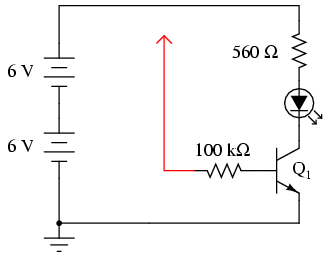
ILLUSTRATION
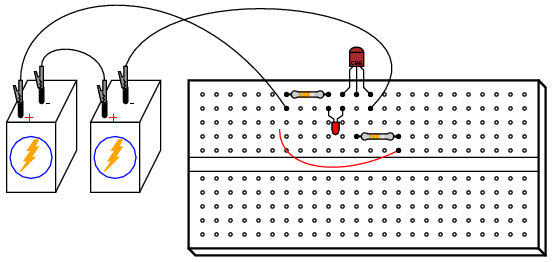
INSTRUCTIONS
The red wire shown in the diagram (the one
terminating in an arrowhead, connected to one end of the 100
kΩ resistor) is intended to remain loose, so that you may
touch it momentarily to other points in the circuit.
If you touch the end of the loose wire to
any point in the circuit more positive than it, such as the
positive side of the DC power source, the LED should light
up. It takes 20 mA to fully illuminate a standard LED, so
this behavior should strike you as interesting, because the
100 kΩ resistor to which the loose wire is attached
restricts current through it to a far lesser value than 20
mA. At most, a total voltage of 12 volts across a 100 kΩ
resistance yields a current of only 0.12 mA, or 120 �A! The
connection made by your touching the wire to a positive
point in the circuit conducts far less current than 1 mA,
yet through the amplifying action of the transistor, is able
to control a much greater current through the LED.
Try using an ammeter to connect the loose
wire to the positive side of the power source, like this:
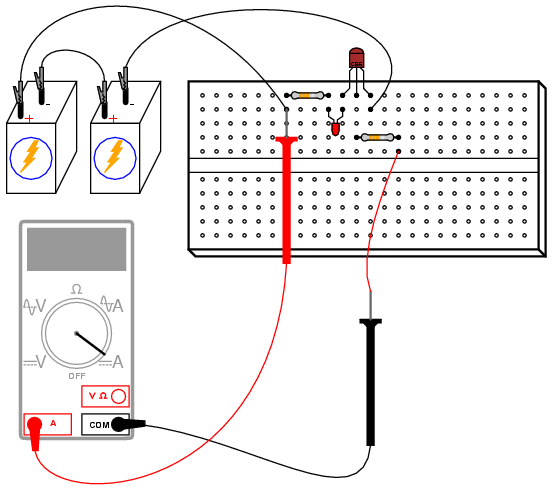
You may have to select the most sensitive
current range on the meter to measure this small flow. After
measuring this controlling current, try measuring the
LED's current (the controlled current) and compare
magnitudes. Don't be surprised if you find a ratio in excess
of 200 (the controlled current 200 times as great as the
controlling current)!
As you can see, the transistor is acting as
a kind of electrically-controlled switch, switching current
on and off to the LED at the command of a much smaller
current signal conducted through its base terminal.
To further illustrate just how miniscule the
controlling current is, remove the loose wire from the
circuit and try "bridging" the unconnected end of the 100 kΩ
resistor to the power source's positive pole with two
fingers of one hand. You may need to wet the ends of those
fingers to maximize conductivity:
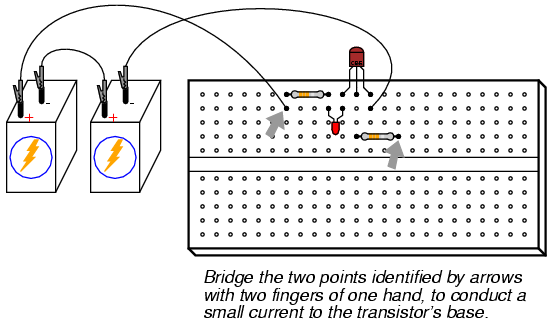
Try varying the contact pressure of your
fingers with these two points in the circuit to vary the
amount of resistance in the controlling current's path. Can
you vary the brightness of the LED by doing so? What does
this indicate about the transistor's ability to act as more
than just a switch; i.e. as a variable
COMPUTER SIMULATION
Schematic with SPICE node numbers:
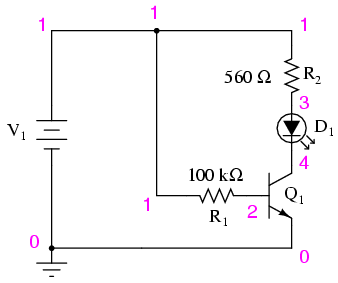
Netlist (make a text file containing the
following text, verbatim):
Transistor as a switch
v1 1 0
r1 1 2 100k
r2 1 3 560
d1 3 4 mod2
q1 4 2 0 mod1
.model mod1 npn bf=200
.model mod2 d is=1e-28
.dc v1 12 12 1
.print dc v(2,0) v(4,0) v(1,2) v(1,3) v(3,4)
.end
In this simulation, the voltage drop across
the 560 Ω resistor v(1,3) turns out to be 10.26
volts, indicating a LED current of 18.32 mA by Ohm's Law
(I=E/R). R1's voltage drop (voltage between nodes
1 and 2) ends up being 11.15 volts, which across 100 kΩ
gives a current of only 111.5 �A. Obviously, a very small
current is exerting control over a much larger current in
this circuit.
In case you were wondering, the is=1e-28
parameter in the diode's .model line is there to
make the diode act more like an LED with a higher forward
voltage drop.
|